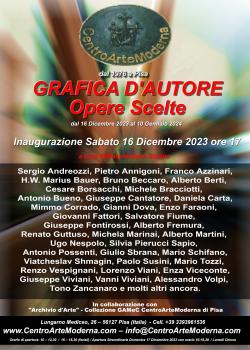
It opens to the public Saturday, December 16, 2023, at 17, the twenty-fourth edition of the exhibition "GRAPHIC AUTHOR SELECTED WORKS". This annual exhibition organized and curated by Massimiliano Sbrana, wants to bring clarity and greater knowledge in the seemingly complicated world of art printing with particular attention to the most contemporary.
The exhibition will continue until 10 January 2024 with free admission.
Opening hours: 10:00-12:30 / 16:00-18:30 (weekdays); closed Monday . Special Opening Sunday 17 December 2023 with hours 16-18,30.
It is increasingly common, unfortunately, in recent years, to witness a real abuse of the term "graphic designer" with prints ( often digital) that are not even worth the paper that is used made in a few hours of work in front of a PC. To create an original graphic design, the process is completely manual. The decomposition of colors is done by hand and so the printing, on special manual presses and, depending on what you want to achieve, need many colors and many days of work in symbiosis, the master printer and the artist author of the subject.
"Art Graphics" means an artistic production by means of printing, reproduced in several copies signed and numbered by the author who conceived the subject and processed the matrix. Although there has always been a graphic production of an artistic order that was "of invention" (the artist is both creator and performer of the graphic subject) or "translation" (the printer artist translates into graphic language the subject of another), the definition of "Art graphics", in the present sense was formed in the 19th century under the pressure of conditions created by the widespread use of new techniques of graphic production that were added to the classic engraving: first of all the lithography (beginning of the 19th century), to which was later added the screen printing (thirties of the 20th century) which, allowing the rendering of chromatic-tonal values, increased gestural spontaneity in the processing of matrices and more uniform quality prints, He expanded the fields of use and opened the way to the taste of a new graphic design, similar in lightness and spontaneity to the design, but also colorful and decorative, of a pictorial character. The term of the definition of art graphics, is acceptable and justified if it refers to the techniques that require the processing of the matrix by the artist, But it cannot be the case for mechanized techniques, and it is therefore necessary to specify their limits and meaning in the various cases. First of all, it must be made clear that graphic production with manual processes always involves a linguistic operation. To the engraver, lithographer or serigraph, both "invention" and "translation", requires not only a technical intervention but a transposition of language, from the global chromatotonal of any existing image or even just thought, to the graphic one, specific to the chosen technique.
The graphic artist "of invention", as are today by definition tacitly agreed all artists who produce art graphics, is from the linguistic point of view a translator of himself, that is of his own works, existing or imagined, to be translated and trained in graphic language. In the classic case of the engraving translation, which here we assume as an example because it summarizes each particular case, the people involved in the production of a graphic work can be: only one when the printing artist is "of invention" (is the author of the subject), or different when the tasks are shared.
In general there is greater division of roles into two or three persons: the author of the subject, the draftsman (translator of the pictorial subject in drawing) and the printer (translator of the original subject), much more often the draftsman and the printer is the same. The artistic value of a graphic work is not, therefore, dependent on its cataloguing as art graphics; this definition is given by the irreducible artistic evaluation, to unique parameters, and is based on the qualification of originality. The artist’s signature therefore wants to certify an originality that is, therefore, more justified to understand as a certificate of authenticity: that that copy was printed from a matrix definable as original and conforms to the definitive proof of author. The numbering is therefore absolutely insignificant, from the artistic point of view, for mechanical, uniform and potentially unlimited editions, while it makes sense for techniques that produce effective and sensitive qualitative variations as the circulation proceeds, both for matrix degradation (e.g. non-steeled tip) and for uncontrollable print uniformity (e.g. multi-color printing by the variable stickiness method of inks e.g. screen printing). In the economics of modern graphic production, therefore, numbering and signature have artistic meaning only for manual techniques.
In this large exhibition will be visible not only art graphics but also unique works on paper such as drawings, pencils, charcoal, blood, watercolors, oils, pastels, tempera, mixed techniques, monotype of the major Italian artists including:
Sergio Andreozzi, Pietro Annigoni, Franco Azzinari, H.W. Marius Bauer, Bruno Beccaro, Alberto Berti, Cesare Borsacchi, Michele Bracciotti, Antonio Bueno, Giuseppe Cantatore, Daniela Carta, Mimmo Corrado, Gianni Dova, Enzo Faraoni, Giovanni Fattori, Salvatore Fiume, Giuseppe Fontirossi, Alberto Fremura, Renato Guttuso, Michela Marinai, Alberto Martini, Ugo Nespolo, Silvia Pierucci Sapio, Antonio Possenti, Giulio Sbrana, Mario Schifano, Viatcheslav Shmagin, Paolo Susini, Mario Tozzi, Renzo Vespignani, Lorenzo Viani, Enza Viceconte, Giuseppe Viviani, Vanni Viviani, Alessandro Volpi, Tono Zancanaro and many more.
For appointments tel 3393961536 (Whatsapp, Signal, Telegram) or www.Centroartemoderna.com